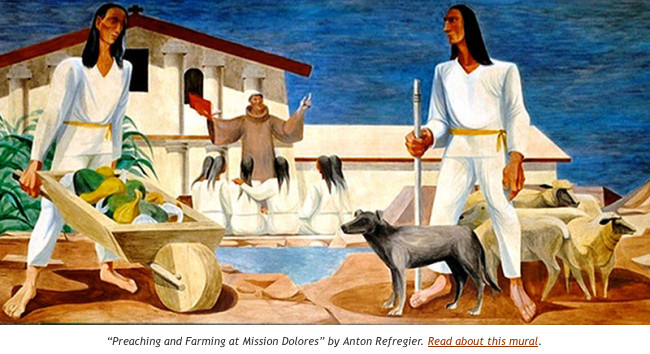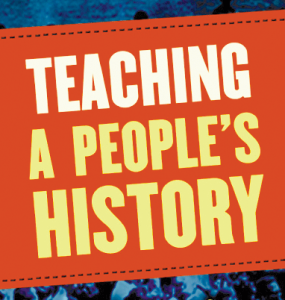Lying to Children About the California Missions and the Indians

*This is relevant considering the recent news about Pope Francis’ decision to canonize Father Junipero Serra. There has been an outcry from the Native American communities regarding the canonization, in fact because of pressure from that community the statue of Serra was removed from Statuary Hall in Washington DC. VL
 By Deborah A. Miranda, Zinn Education Project
By Deborah A. Miranda, Zinn Education Project
All my life, I have heard only one story about California Indians: godless, dirty, stupid, primitive, ugly, passive, drunken, immoral, lazy, weak-willed people who might make good workers if properly trained and motivated. What kind of story is that to grow up with?
The story of the missionization of California.
In 1769, after missionizing much of Mexico, the Spaniards began to move up the west coast of North America in order to establish claims to rich resources and before other European nations could get a foothold. Together, the Franciscan priests and Spanish soldiers “built” a series of 21 missions along what is now coastal California. (California’s Indigenous peoples, numbering more than 1 million at the time, did most of the actual labor.) These missions, some rehabilitated from melting adobe, others in near-original state, are now one of the state’s biggest tourist attractions; in the little town of Carmel, Mission San Carlos Borromeo de Carmelo is the biggest attraction. Elsewhere, so-called Mission décor drenches Southern California, from restaurants to homes, apartment buildings, animal shelters, grocery stores, and post offices. In many neighborhoods, a bastardized Mission style is actually required by cities or neighborhood associations. Along with this visual mythology of adobe and red clay roof tiles comes the cultural storytelling that drains the missions of their brutal and bloody pasts for popular consumption.

In California schools, students come up against the “Mission Unit” in 4th grade, reinforcing the same lies those children have been breathing in most of their lives. Part of California’s history curriculum, the unit is entrenched in the educational system and impossible to avoid, a powerfully authoritative indoctrination in Mission Mythology to which 4th graders have little if any resistance. Intense pressure is put upon students (and their parents) to create a “Mission Project” that glorifies the era and glosses over both Spanish and Mexican exploitation of Indians, as well as enslavement of those same Indians during U.S. rule. In other words, the Mission Unit is all too often a lesson in imperialism, racism, and Manifest Destiny rather than actually educational or a jumping-off point for critical thinking or accurate history.
In Harcourt School Publisher’s California: A Changing State, the sacrifice for gold, riches, settlements, and violence by Spanish, English, and Russian explorers is well enunciated throughout Unit 2 and dressed in exciting language such as on page 113: “In one raid, Drake’s crew took 80 pounds of gold!”
In four opening pages to Chapter 3 devoted to Father Junípero Serra, the textbook urges students to sympathize with the Spanish colonial mission:
Mile after mile, day after day, week after week, the group traveled across the rugged terrain. As their food ran low, many of the men grew tired and sick. Father Serra himself suffered from a sore on one leg that grew worse each day. And yet he never gave up, calling on his faith in God to keep himself going.
The language jumps between an acknowledgement of the subjugation of Indigenous peoples and of mutually beneficial exchanges. In Lesson 3, “The Mission System” opens: “Indians were forced to build a chain of missions.” Subsequent language emphasizes the alleged benefits to the Indians:
At the missions, the priests worked to create loyal Spanish subjects. . . . They would move the California Indians into the missions, teach them to be Christians, and show them European ways. [Emphasis added.]
Visiting the mission as an adult, proud, mixed-blood California Indian woman, I found myself unprepared for gift shops well stocked with CDs of pre-researched Mission Projects; photocopied pamphlets of mission terms, facts, and history (one for each mission); coloring books; packaged models of missions (“easy assembly in 10 minutes!”); and other project paraphernalia for the discerning 4th grader and his or her worried parents.
The Carmel Mission website maintains a “4th Grade Corner” where daily life for padres and their “Indian friends” who “shared what little food and supplies they had” is blissfully described. Other websites offer “easy,” “quick,” and “guaranteed A+!!!” Mission Projects, targeting those anxious parents, for a price.
Generations of Californians have grown up steeped in a culture and education system that trains them to think of Indians as passive, dumb, and disappeared. In other words, the project is so well established, in such a predictable and well-loved rut, that veering outside of the worn but comfortable mythology is all but impossible.
On my visit to Mission Dolores, I found that out in a particularly visceral way.
It was over winter break, 2008. I was in San Francisco for a conference, and my friend Kimberly and I had hopped on a streetcar to visit Mission Dolores. As we emerged from the mission church via a side door into a small courtyard (featuring one of those giant dioramas behind glass), we inadvertently walked into video range of a mother filming her daughter’s 4th-grade project.
Excusing ourselves, we studiously examined the diorama while the little girl flubbed her lines a few times. She was reading directly from the flyer given tourists in the gift shop and could say “basilica” but not “archdiocese,” but she maintained her poise through several takes until she nailed it.
Both mothers ourselves, Kimberly and I paused to exchange a few words of solidarity about school projects with the mother, which gave Mom the chance to brag about how she and Virginia were trying to “do something a little different” by using video instead of making a model.
“That’s great!” I said, giving them both a polite smile. “I’ll bet your teacher will be glad to have something out of the ordinary.”
“Well, it is different actually being right here,” Mom said excitedly. “To think about all those Indians and how they lived all that time ago, that’s kind of impressive.”
I could not resist: “And better yet,” I beamed, “still live! Guess what? I’m a member of the Ohlone/Costanoan-Esselen Nation myself! Some of my ancestors lived in this mission. I’ve found their names in the Book of Baptism.” (I didn’t mention that they are also listed in the Book of Deaths soon afterward.)

The mother was beside herself with pleasure, posed me with her daughter for a still photo, and wrote down my name so she could Google my work. Little Virginia, however, was shocked into silence. Her face drained, her body went stiff, and she stared at me as if I had risen, an Indigenous skeleton clad in decrepit rags, from beneath the clay bricks of the courtyard. Even though her mother and I talked a few more minutes, Virginia the 4th grader—previously a calm, articulate news anchor in training—remained a shy shadow, shooting side glances at me out of the corner of her eyes.
As Kimberly and I walked away, I thought, “That poor kid has never seen a live Indian, much less a ‘Mission Indian’—she thought we were all dead!” Having me suddenly appear in the middle of her video project must have been a lot like turning the corner to find the (dead) person you were talking about suddenly in your face, talking back.
Kimberly, echoing my thoughts, chortled quietly, “Yes, Virginia, there really are live Mission Indians.”
The problem is, thanks to Mission Mythology, most 4th graders will never know that and the textbooks don’t help to give visibility to modern California Indians.
Throughout the rest of California: A Changing History, mentions of California Indians are brief and as victims fading into history. On page 242, under the heading of “A Changing Population,” Harcourt states simply, “California Indians were hurt by the gold rush. . . . Many were forced off their lands when the miners found gold there.”
Many pages later, California Indians are mentioned again when the textbook devotes five paragraphs to Indian Governments. Although 109 tribes are recognized in California, in the text, they are faceless and noted only by red square dots on a map.
It’s time for the Mission Fantasy Fairy Tale to end. This story has done more damage to California Indians than any conquistador, any priest, and soldado de cuera (leather-jacket soldier), any smallpox, measles, or influenza virus. This story has not just killed us, it has also taught us to kill ourselves and kill each other with alcohol, domestic violence, horizontal racism, internalized hatred.
We have to put an end to it now.
This article was originally published in Zinn Education Project.
This article is adapted from Deborah Miranda’s book Bad Indians: A Tribal Memoir and is reprinted here with permission of the author. This article is part of the Zinn Education Project’s If We Knew Our History series.
Deborah A. Miranda is the author of Bad Indians: A Tribal Memoir (Heyday Books, 2012). Miranda is an enrolled member of the Ohlone /Costanoan-Esselen Nation of California, and is also of Chumash and Jewish ancestry. She is a John Lucian Smith Jr. Professor of English at Washington and Lee University, and says reading lists for her students include as many books by “bad Indians” as possible. Visit Deborah Miranda’s blog, BAD NDNS.
[Photos courtesy of Zinn Education Project]




